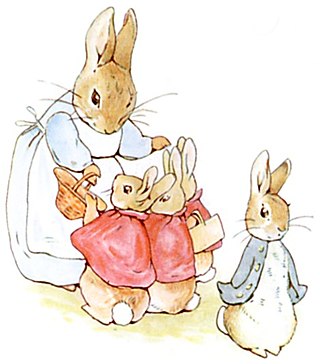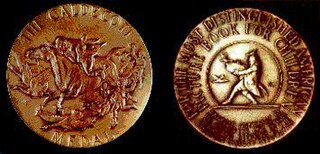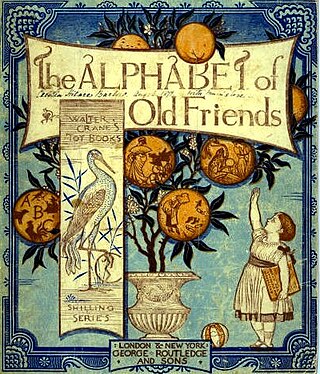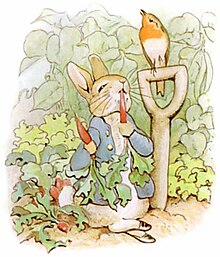
Children's literature or juvenile literature includes stories, books, magazines, and poems that are created for children. Modern children's literature is classified in two different ways: genre or the intended age of the reader, from picture books for the very young to young adult fiction.

Catherine Greenaway was an English Victorian artist and writer, known for her children's book illustrations. She received her education in graphic design and art between 1858 and 1871 from the Finsbury School of Art, the South Kensington School of Art, the Heatherley School of Art, and the Slade School of Fine Art. She began her career designing for the burgeoning holiday card market, producing Christmas and Valentine's cards. In 1879 wood-block engraver and printer Edmund Evans printed Under the Window, an instant best-seller, which established her reputation. Her collaboration with Evans continued throughout the 1880s and 1890s.

A picture book combines visual and verbal narratives in a book format, most often aimed at young children. With the narrative told primarily through text, they are distinct from comics, which do so primarily through sequential images. The images in picture books can be produced in a range of media, such as oil paints, acrylics, watercolor, and pencil. Picture books often serve as pedagogical resources, aiding with children's language development or understanding of the world.

The Randolph Caldecott Medal, frequently shortened to just the Caldecott, annually recognizes the preceding year's "most distinguished American picture book for children". It is awarded to the illustrator by the Association for Library Service to Children (ALSC), a division of the American Library Association (ALA). The Caldecott and Newbery Medals are considered the most prestigious American children's book awards. Beside the Caldecott Medal, the committee awards a variable number of citations to runners-up they deem worthy, called the Caldecott Honor or Caldecott Honor Books.

Raymond Redvers Briggs was an English illustrator, cartoonist, graphic novelist and author. Achieving critical and popular success among adults and children, he is best known in Britain for his 1978 story The Snowman, a book without words whose cartoon adaptation is televised and whose musical adaptation is staged every Christmas.
The Carnegie Medal for Illustration is a British award that annually recognises "distinguished illustration in a book for children". It is conferred upon the illustrator by the Chartered Institute of Library and Information Professionals (CILIP) which inherited it from the Library Association. CILIP is currently partnered with the audio technology company Yoto in connection with the award, though their sponsorship and the removal of Greenaway’s name from the medal proved controversial.
Leo Dillon and Diane Dillon were American illustrators of children's books and adult paperback book and magazine covers. One obituary of Leo called the work of the husband-and-wife team "a seamless amalgam of both their hands". In more than 50 years, they created more than 100 speculative fiction book and magazine covers together as well as much interior artwork. Essentially all of their work in that field was joint.

Charles William James Keeping was an English illustrator, children's book author and lithographer. He made the illustrations for Rosemary Sutcliff's historical novels for children, and he created more than twenty picture books. He also illustrated the complete works of Charles Dickens for the Folio Society.

Candlewick Press, established in 1992 and located in Somerville, Massachusetts, is part of the Walker Books group. The logo depicting a bear carrying a candle is based on Walker Books's original logo.

Lane Smith is an American illustrator and writer of children's books. He is the Kate Greenaway medalist (2017) known for his eclectic visuals and subject matter, both humorous and earnest, such as the contemplative Grandpa Green, which received a Caldecott Honor in 2012, and the outlandish Stinky Cheese Man, which received a Caldecott Honor in 1992.
Gail E. Haley is an American writer and illustrator. She has won the annual awards for children's book illustration from both the American and British librarians, for two different picture books. She won the 1971 Caldecott Medal for A Story a Story, which she retold from an African folktale, and the 1976 Kate Greenaway Medal for The Post Office Cat, her own historical fiction about a London post office.
Nonny Hogrogian is an Armenian-American writer and illustrator, known best for children's picture books. She has won two annual Caldecott Medals for U.S. children's book illustrations. Since childhood she prefers folk and fairy tales, poetry, fantasy and stories.
Molly Garrett Bang is an American illustrator. For her illustration of children's books she has been a runner-up for the American Caldecott Medal three times and for the British Greenaway Medal once. Announced June 2015, her 1996 picture book Goose is the 2016 Phoenix Picture Book Award winner – that is, named by the Children's Literature Association the best English-language children's picture book that did not win a major award when it was published twenty years earlier.
The Kurt Maschler Award was a British literary award that annually recognised one "work of imagination for children, in which text and illustration are integrated so that each enhances and balances the other." Winning authors and illustrators received £1000 and a bronze figurine called the "Emil".

Edmund Evans was an English wood-engraver and colour printer during the Victorian era. He specialized in full-colour printing, a technique which, in part because of his work, became popular in the mid-19th century. He employed and collaborated with illustrators such as Walter Crane, Randolph Caldecott, Kate Greenaway and Richard Doyle to produce what are now considered to be classic children's books. Little is known about his life, although he wrote a short autobiography before his death in 1905 in which he described his life as a printer in Victorian London.
Helen Gillian Oxenbury is an English illustrator and writer of children's picture books. She lives in North London. She has twice won the annual Kate Greenaway Medal, the British librarians' award for illustration and been runner-up four times. For the 50th anniversary of that Medal (1955–2005) her 1999 illustrated edition of Alice's Adventures in Wonderland was named one of the top ten winning works.

The illustration of manuscript books was well established in ancient times, and the tradition of the illuminated manuscript thrived in the West until the invention of printing. Other parts of the world had comparable traditions, such as the Persian miniature. Modern book illustration comes from the 15th-century woodcut illustrations that were fairly rapidly included in early printed books, and later block books. Other techniques such as engraving, etching, lithography and various kinds of colour printing were to expand the possibilities and were exploited by such masters as Daumier, Doré or Gavarni.

Toy books were illustrated children's books that became popular in England's Victorian era. The earliest toy books were typically paperbound, with six illustrated pages and sold for sixpence; larger and more elaborate editions became popular later in the century. In the mid-19th century picture books began to be made for children, with illustrations dominating the text rather than supplementing the text.

Jon Klassen is a Canadian writer and illustrator of children's books and an animator. He won both the American Caldecott Medal and the British Kate Greenaway Medal for children's book illustration, recognizing the 2012 picture book This Is Not My Hat, which he also wrote. He is the first person to win both awards for the same work.

This Is Not My Hat is a 2012 American children's picture book by the author and illustrator Jon Klassen. The story is told through the unreliable narration of a little fish, who has stolen a hat from a big fish and how the big fish reacts to the theft. It is a thematic follow-up to I Want My Hat Back (2011) and was meant to be a more literal sequel until Klassen took a suggestion to change which animals were in the story. The book was well received by critics who praised its dark or ironic humor which could only be understood by comparing the words of the little fish's narration against the events of the illustrations. In addition to several positive reviews, Klassen received the 2013 Caldecott Medal and the 2014 Kate Greenaway Medal becoming the first book to win both awards. This is Not My Hat was also a commercial success.














